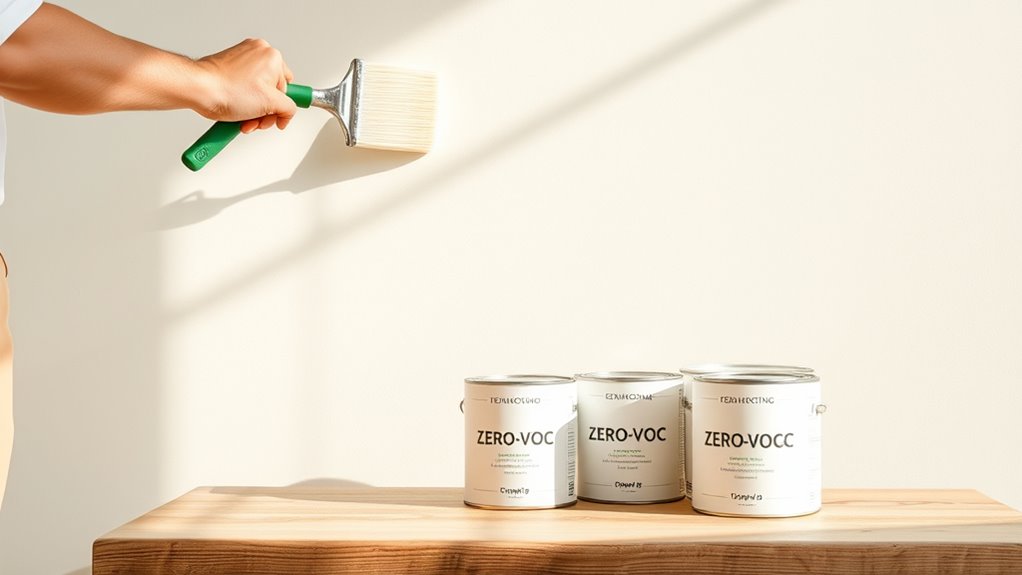Choosing zero-VOC paint for your next project matters because it dramatically improves indoor air quality by eliminating harmful chemicals that off-gas for years. It reduces health risks like respiratory issues, headaches, and long-term illnesses, especially for vulnerable people. Plus, it’s better for the environment by cutting down on toxic emissions and pollution. If you want a safer, eco-friendly space and want to learn more about the benefits, keep exploring this important choice.
Key Takeaways
- Zero-VOC paints eliminate harmful chemical emissions, improving indoor air quality and protecting health, especially for sensitive individuals.
- They reduce long-term health risks like respiratory issues, headaches, and cancers linked to VOC exposure.
- Using zero-VOC paints supports eco-friendly building practices by minimizing environmental pollution and chemical runoff.
- They provide durable, vibrant colors without harmful fumes, ensuring a safer, healthier living or working environment.
- Choosing zero-VOC paint aligns with sustainability goals and can lead to cost savings on healthcare and maintenance over time.
Understanding VOCs and Their Impact on Indoor Air Quality

Have you ever wondered what’s in the paint you use and how it affects your indoor air? VOCs, or Volatile Organic Compounds, are harmful chemicals found in many paints that vaporize at room temperature. When you paint, these chemicals off-gas into your indoor environment, contaminating the air you breathe. This off-gassing can continue for months or even years after application, gradually impacting air quality. Exposure to VOCs has been linked to health issues like respiratory problems, headaches, dizziness, and an increased risk of cancer. Choosing low or zero-VOC paints helps reduce this chemical release. Proper ventilation during and after painting also plays a vital role in minimizing VOC buildup, making your indoor space safer and healthier over time. Additionally, understanding how indoor air quality is affected by various household products can help you make more informed choices to create a healthier living environment. Being aware of indoor pollutants can further guide you in selecting safer household materials. For example, using air purifiers with HEPA filters can help remove residual pollutants from the air and improve overall indoor air quality. Incorporating Vetted eco-friendly paints can further enhance your efforts to maintain a healthier indoor environment. Furthermore, adopting integrated safety practices can optimize your efforts to reduce chemical exposure indoors.
The Health Risks Associated With Voc-Emitting Paints
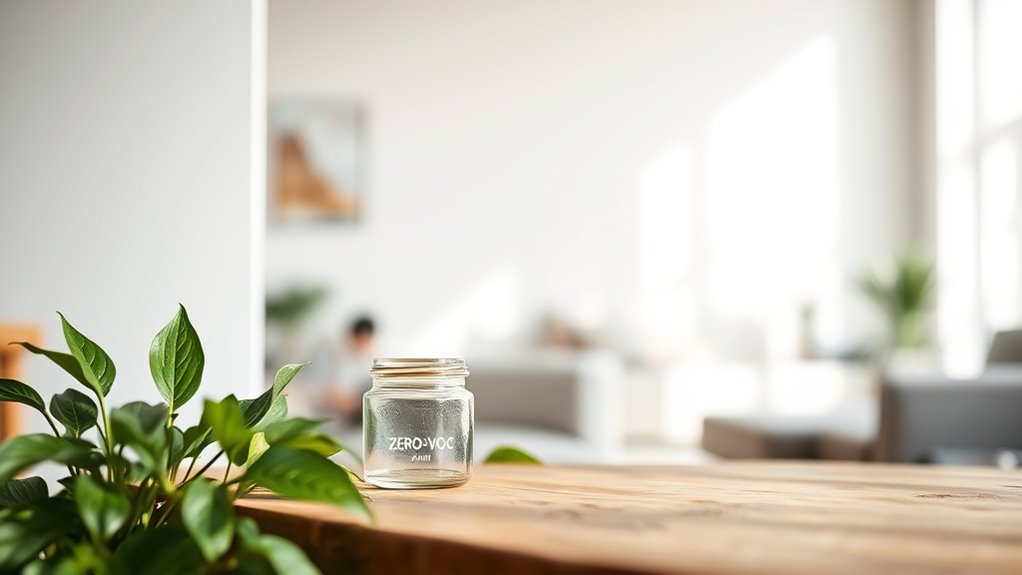
When you use paints that emit VOCs, you expose yourself and your family to chemicals linked to cancer and other serious health issues. Breathing in these fumes can cause immediate problems like headaches and respiratory discomfort, especially for vulnerable groups like children and pregnant women. Since VOCs off-gas for months or years, the risks persist long after the paint is applied. Additionally, automated insights from AI technologies can help consumers make more informed choices about product safety and environmental impact. In ancient wisdom, the importance of truth and integrity reminds us to choose products that are safe and honest in their claims. Selecting low-VOC or zero-VOC paints ensures a healthier environment and reduces long-term health hazards. Understanding VOCs and their effects highlights the importance of choosing safer alternatives for your home.
Carcinogenic Chemical Exposure
Did you know that exposure to volatile organic compounds (VOCs) in paints can pose serious health risks? VOCs can contain carcinogenic chemicals like benzene and formaldehyde, which increase your long-term cancer risk. Off-gassing can last months or even years, continuously exposing you to these harmful carcinogens. Prolonged exposure has been linked to higher rates of respiratory cancers and other health issues. Vulnerable groups like children, pregnant women, and immune-compromised individuals face even greater risks. To illustrate, consider the following:
| Carcinogenic Chemicals | Health Risks |
|---|---|
| Benzene | Increased cancer risk |
| Formaldehyde | Respiratory and cancer issues |
| Toluene | Nervous system damage |
| Xylene | Organ toxicity |
Switching to zero-VOC paints can noticeably reduce carcinogenic chemical exposure, protecting your health. Understanding chemical emissions] from paints underscores the importance of choosing safer alternatives.
Respiratory Health Risks
Exposure to VOC-emitting paints doesn’t just pose long-term cancer risks; it also presents immediate respiratory health concerns. When you use traditional paints, harmful VOCs like formaldehyde and benzene are released into the air, irritating your respiratory system. Off-gassing from these paints can cause symptoms such as coughing, wheezing, shortness of breath, and chest tightness. Children, pregnant women, and those with pre-existing respiratory conditions are especially vulnerable to these effects. Continuous inhalation of VOCs can lead to more serious issues like asthma, chronic bronchitis, and decreased lung function over time. By choosing zero-VOC paints, you reduce your exposure to these harmful chemicals, helping to protect your respiratory health and improve indoor air quality immediately. Using self watering plant pots can also contribute to a healthier indoor environment by maintaining optimal humidity levels.
Long-Term Off-Gassing Effects
VOCs can off-gas from paint for months or even years after application, continuously releasing harmful chemicals into your indoor air. This persistent VOC off-gas keeps harmful emissions present long after painting, leading to ongoing health risks. Over time, prolonged exposure increases your chances of developing respiratory issues, headaches, dizziness, and even more severe problems like cancer. Indoor environments with high VOC levels from legacy paints may experience persistent air pollution for decades, impacting vulnerable groups like children and pregnant women. Choosing zero-VOC paints dramatically reduces this long-term risk, cutting down on chemical off-gassing and improving indoor air quality. Additionally, air exchange in your home can help reduce VOC buildup, further safeguarding your health. By understanding the long-term effects of VOC off-gas, you can make smarter choices for healthier, safer living spaces.
How Zero-VOC Paints Promote a Safer Living Environment

Zero-VOC paints play a essential role in creating a safer living environment by eliminating the harmful off-gassing associated with traditional paints. Without VOCs, these paints do not release volatile organic compounds that can compromise indoor air quality. This reduction in off-gas helps lower your exposure to chemicals linked to respiratory issues, headaches, and long-term health risks. Over time, zero-VOC formulations also minimize pollutant release, ensuring your space remains healthier during and after painting. Indoor air pollution can be up to five times higher than outdoor levels, but choosing zero-VOC paints considerably lessens this risk. Here’s a visual breakdown:
| Benefit | Explanation |
|---|---|
| No off-gas | Eliminates harmful VOC emissions |
| Healthier air | Reduces exposure to chemicals |
| Long-term safety | Continual pollutant minimization |
| Safer for sensitive groups | Protects pregnant women, children |
| Indoor air quality | Maintains cleaner, healthier environment |
Environmental Benefits of Choosing Zero-VOC Options

Choosing zero-VOC paints helps improve your indoor air quality by reducing harmful emissions. It also limits chemical runoff that can pollute water sources and contribute to smog. By selecting these eco-friendly options, you support sustainable building practices and protect the environment. Additionally, opting for zero-VOC paints promotes air purification technology, reminding us of the importance of nurturing and caring for our surroundings for future generations. Incorporating such environmentally conscious choices can also reduce the need for frequent air purification, thereby enhancing air quality over time.
Reduces Indoor Air Pollution
Because they emit little to no volatile organic compounds, zero-VOC paints considerably improve indoor air quality. They make sure your home stays healthier by reducing VOC levels, which notably cuts down indoor air pollution. With much less off-gassing during and after your painting project, you’ll notice fewer headaches, dizziness, and respiratory issues. Choosing zero-VOC paints also makes it much easier to pick your favorite Paint Colors without worrying about harmful chemicals. When I really went to a local paint store for my next project, I saw many options from Benjamin Moore and Benjamin Moores that are zero-VOC. It’s a smart choice, especially because these low-emission paints help keep indoor air cleaner for two years and beyond. This way, you can enjoy a safer, healthier environment with less hassle. Proper ventilation during and after painting further enhances indoor air quality and reduces lingering fumes. Additionally, incorporating sound healing science techniques like calming sounds can promote relaxation and reduce stress during home renovation projects.
Limits Harmful Chemical Release
By releasing no volatile organic compounds during application or off-gassing, zero-VOC paints greatly reduce harmful chemical emissions into the environment. This decrease in volatile organic compounds helps lower indoor air pollution and prevents the spread of toxic chemicals into surrounding ecosystems. Choosing zero-VOC options also supports stricter environmental regulations aimed at cutting chemical emissions at a broader level. These paints minimize the release of harmful substances into soil and water through runoff, protecting ecosystems and water quality. Additionally, zero-VOC paints contribute to reducing the overall carbon footprint associated with traditional paint manufacturing and disposal. By limiting the release of volatile organic compounds, you help promote a cleaner, healthier environment for everyone.
Supports Sustainable Building Practices
Supporting sustainable building practices is essential for reducing environmental impact, and zero-VOC paints play a key role in this effort. By choosing zero-VOC options, you help lower harmful chemical emissions that contribute to smog and environmental degradation. These paints are often made from renewable or biodegradable ingredients, aligning with eco-friendly manufacturing standards. Using zero-VOC paints also decreases the overall carbon footprint of your construction or renovation projects. When you opt for these paints, you’re not only improving indoor air quality but also encouraging industry-wide shifts toward environmentally responsible formulations. This promotes long-term sustainability in building practices and supports a healthier planet. Incorporating eco-friendly manufacturing standards can also enhance the overall sustainability of your projects. Additionally, incorporating essential oils in your projects can also enhance indoor air quality by providing natural, non-toxic scents that promote well-being. Embracing remote hackathons can foster innovative approaches and collaboration in developing greener building solutions.
The Difference Between Low-VOC and Zero-VOC Paints
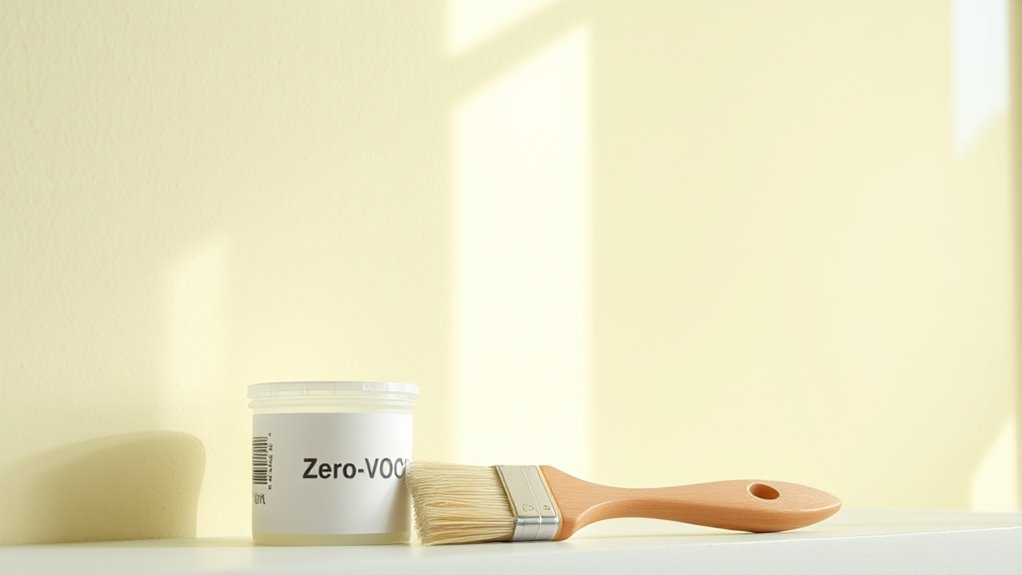
Have you ever wondered what truly sets zero-VOC paints apart from low-VOC options? The main difference lies in their VOC content, which impacts paint color choices and safety. Zero-VOC paints contain no volatile organic compounds, making them the safest for indoor air quality and minimizing off-gassing. In contrast, low-VOC paints have reduced but measurable VOC levels, and there’s no strict industry standard defining their limits. While both are marketed as eco-friendly, zero-VOC paints offer the highest assurance of chemical-free paint color options and safer indoor environments. If you’re sensitive to fumes or want the cleanest option, zero-VOC paints are the way to go. They eliminate concerns about VOC emissions during and after application, ensuring a healthier space.
Off-Gassing Duration and How to Minimize Exposure

You can minimize your exposure to VOCs by ensuring proper ventilation during and after painting, which helps clear out chemicals faster. Using zero-VOC paints and following recommended drying techniques reduce off-gassing and improve indoor air quality over time. Keeping spaces well-ventilated long-term is key to maintaining a healthier indoor environment.
Ventilation Strategies Matter
Effective ventilation is essential for reducing indoor VOC levels during and after painting, as most off-gassing occurs within the first six months. To minimize exposure, you should prioritize increasing airflow with open windows and fans, which accelerates VOC dissipation. Maintaining continuous airflow for at least 48 hours helps lower VOC concentrations, protecting your health. Proper ventilation strategies are especially important when using low or zero-VOC paints, as residual off-gassing can still occur over time. Here are some key tips:
- Open windows and doors during and after painting
- Use fans to improve airflow
- Keep windows open for at least 48 hours
- Avoid closed-off spaces immediately after painting
- Regularly ventilate to maintain good indoor air quality
Implementing these strategies ensures your next paint project contributes less to indoor air pollution.
Proper Drying Techniques
Proper drying techniques are essential for minimizing off-gassing duration and reducing your exposure to VOCs. To do this, apply paint in thin, even coats and allow each layer to dry thoroughly before adding another. Maintaining consistent indoor temperature and humidity levels speeds up VOC dissipation and prevents prolonged emissions. Using low- or zero-VOC paints further shorten off-gassing time compared to traditional options. Ventilate well during and after painting to accelerate VOC dispersal and clear indoor air. Keep windows open and use fans to promote airflow. Remember, most VOCs off-gas considerably within the first six months, but some can persist for years if conditions aren’t ideal. Proper drying techniques help ensure that you minimize health risks and enjoy a cleaner, safer indoor environment.
Long-Term Indoor Air Quality
While good drying techniques help reduce short-term VOC exposure, understanding the long-term impact of off-gassing is equally important for maintaining healthy indoor air quality. Most VOCs from paint off-gas within the first six months, but some can emit fumes for up to 20 years, affecting your indoor environment over time. Proper ventilation during and after painting can considerably cut down VOC levels, helping you breathe easier. Choosing zero-VOC or low-VOC paints minimizes ongoing emissions, reducing your risk of respiratory issues. Regular air quality testing and allowing sufficient curing time are essential steps to ensure VOCs drop to safe levels.
- Ventilate well during and after painting
- Opt for zero-VOC or low-VOC paints
- Test indoor air quality periodically
- Allow ample curing time before occupancy
- Be mindful of long-term off-gassing sources
Key Features to Look for When Selecting Zero-VOC Paints
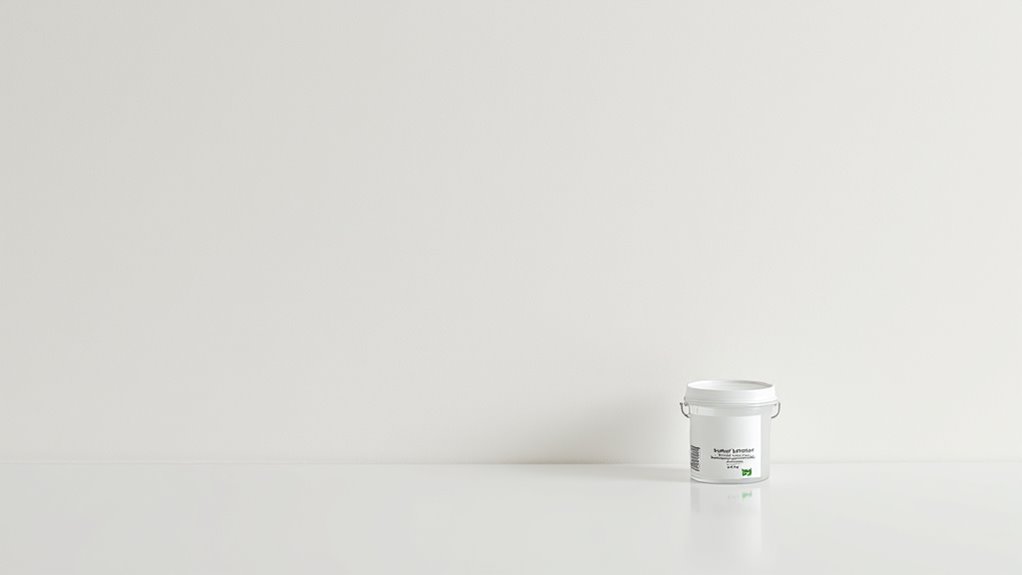
When choosing zero-VOC paints, it’s vital to look for specific features that guarantee you’re selecting a truly eco-friendly and safe product. First, check for labels like “Zero VOC” or “No VOC,” which indicate the paint contains no volatile organic compounds. Look for third-party certifications such as Green Seal (GS-11), confirming the product’s low or zero VOC content and environmentally responsible formulation. Review the VOC levels on the specifications—aim for less than 5 grams per liter. Also, verify the tint used to create colors is low or zero VOC, as tints can add to the VOC content. Finally, choose brands known for transparency and detailed ingredient disclosures, so you can verify that both the base paint and colorants are free from VOCs.
The Long-Term Cost Savings of Using Safer Paints

Choosing zero-VOC paints not only benefits your health and the environment but also offers significant long-term savings. Although they might cost slightly more upfront, you’ll save on medical bills caused by VOC-related health issues and lower cleaning costs from reduced off-gassing. Using zero-VOC paints decreases indoor air pollution, which means you’ll spend less on air purifiers and ventilation systems over time. Plus, these paints help extend the life of your painted surfaces by preventing chemical breakdown, reducing the need for frequent repaints. The health benefits also mean fewer doctor visits and lower healthcare costs. Additionally, their eco-friendly nature can lead to regulatory incentives and tax benefits, adding to your savings.
- Lower healthcare expenses over time
- Reduced cleaning and maintenance costs
- Longer-lasting painted surfaces
- Energy savings from less ventilation
- Potential tax incentives for eco-friendly choices
Common Myths About Zero-VOC Paints Debunked
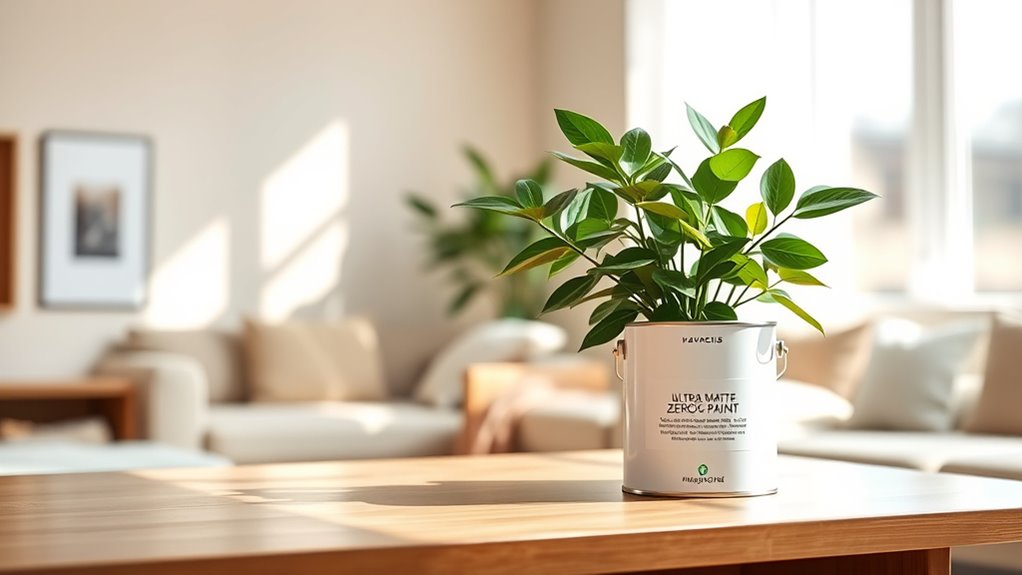
Many myths about zero-VOC paints persist, but these misconceptions often stem from outdated information or misunderstandings. You might think zero-VOC paints aren’t durable, but modern formulations match or even surpass traditional paints in washability and longevity. Another myth is that zero-VOC options lack color variety, yet manufacturers now offer extensive palettes, including custom shades. Some believe these paints are significantly more expensive, but increased competition has brought prices in line with low-VOC paints. It’s also thought that zero-VOC paints can’t achieve high-gloss finishes, but many brands now produce glossy, VOC-free options. In conclusion, you may assume zero-VOC paints offer poor coverage, but advances in pigment technology have improved coverage and ease of application. These myths are simply outdated and don’t reflect current paint innovations.
Practical Tips for Ensuring a Safe and Eco-Friendly Painting Project
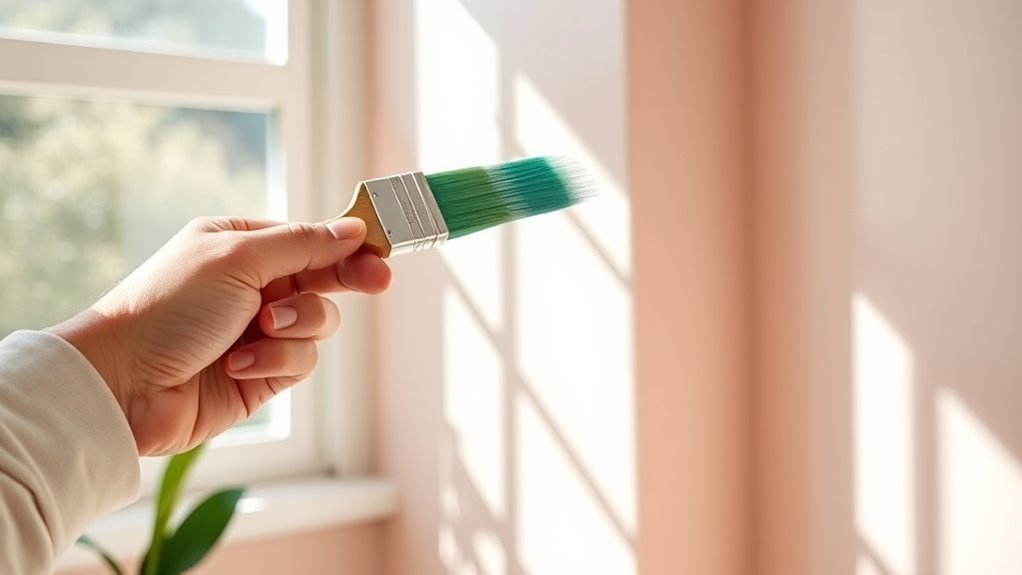
To guarantee your painting project is safe and eco-friendly, start by selecting zero-VOC paints that carry trusted certifications like Green Seal (GS-11), which confirm they meet strict environmental standards. This assures you’re using products that are healthier for you and the planet. Next, properly ventilate your space during and after painting to help VOCs off-gas quickly and improve indoor air quality. Always test paint colors on small areas in different lighting to see how they look before committing to a full coat. When buying, verify that both the paint and tint are low or zero VOCs, as tinting agents can contain VOCs. Finally, store leftover paint in a cool, dry place, sealing containers tightly to prevent off-gassing and ensure safe disposal or future use.
Frequently Asked Questions
What Happens if Paint Is Not Stirred?
If you don’t stir your paint, it can cause pigment and binder separation, leading to uneven color and texture. You might notice inconsistent sheen and coverage, making it hard to get a smooth finish. Unmixed paint can also release VOCs unevenly, affecting indoor air quality. Plus, poor mixing weakens adhesion and durability, causing your paint job to look mismatched and wear out faster over time.
Does Sherwin Williams Have Zero VOC Paint?
Imagine choosing a gentle breeze over a storm—Sherwin-Williams offers that calm with their zero-VOC paints. Yes, their “Harmony” line is designed for interior use and contains no volatile organic compounds. You can trust these paints to provide high-quality coverage without harmful emissions. Available in various sheens, they meet strict environmental standards like Green Seal Certification, helping you create a healthier, eco-friendly space effortlessly.
Why Does Paint Need to Be Shaken?
You need to shake paint to make certain it’s properly mixed before use. When you shake it, you redistribute pigments, binders, and additives evenly throughout the container. This prevents streaks, uneven coverage, and color inconsistencies. For zero-VOC paints, shaking is especially important because their formulas lack heavy fillers, so proper mixing guarantees a smooth application and peak performance. Failing to shake can lead to a rough finish and poor adhesion.
What Is the Best Sheen for Trim Paint?
You’re probably wondering what sheen is best for trim, right? Well, skip the dull, flat options—those are for walls, not trim. Satin or semi-gloss finishes are your best bet because they’re durable, easy to clean, and give a nice subtle shine that highlights details. Plus, they resist stains and moisture, so your trim stays fresh. Basically, go glossy enough to impress but not so much you blind everyone.
Conclusion
Choosing zero-VOC paint isn’t just good for your health—it’s a smart move for the planet. Did you know that indoor air can be up to five times more polluted than outdoor air? By selecting zero-VOC options, you reduce harmful emissions and create a safer, cleaner space for everyone. Making this simple switch not only protects your family but also supports a healthier environment for future generations. Start your eco-friendly painting project today and breathe easier tomorrow.
